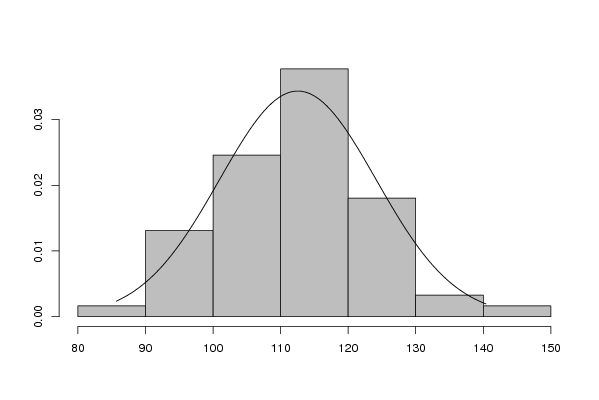Free Statistics
of Irreproducible Research!
Description of Statistical Computation | |||||||||||||||||||||||||||||||||||||||
|---|---|---|---|---|---|---|---|---|---|---|---|---|---|---|---|---|---|---|---|---|---|---|---|---|---|---|---|---|---|---|---|---|---|---|---|---|---|---|---|
| Author's title | |||||||||||||||||||||||||||||||||||||||
| Author | *The author of this computation has been verified* | ||||||||||||||||||||||||||||||||||||||
| R Software Module | rwasp_fitdistrnorm.wasp | ||||||||||||||||||||||||||||||||||||||
| Title produced by software | Maximum-likelihood Fitting - Normal Distribution | ||||||||||||||||||||||||||||||||||||||
| Date of computation | Mon, 10 Nov 2008 15:36:30 -0700 | ||||||||||||||||||||||||||||||||||||||
| Cite this page as follows | Statistical Computations at FreeStatistics.org, Office for Research Development and Education, URL https://freestatistics.org/blog/index.php?v=date/2008/Nov/10/t1226356756zo7bizf59rvdqpv.htm/, Retrieved Sun, 19 May 2024 08:45:41 +0000 | ||||||||||||||||||||||||||||||||||||||
| Statistical Computations at FreeStatistics.org, Office for Research Development and Education, URL https://freestatistics.org/blog/index.php?pk=23219, Retrieved Sun, 19 May 2024 08:45:41 +0000 | |||||||||||||||||||||||||||||||||||||||
| QR Codes: | |||||||||||||||||||||||||||||||||||||||
|
| |||||||||||||||||||||||||||||||||||||||
| Original text written by user: | |||||||||||||||||||||||||||||||||||||||
| IsPrivate? | No (this computation is public) | ||||||||||||||||||||||||||||||||||||||
| User-defined keywords | |||||||||||||||||||||||||||||||||||||||
| Estimated Impact | 180 | ||||||||||||||||||||||||||||||||||||||
Tree of Dependent Computations | |||||||||||||||||||||||||||||||||||||||
| Family? (F = Feedback message, R = changed R code, M = changed R Module, P = changed Parameters, D = changed Data) | |||||||||||||||||||||||||||||||||||||||
| F [Partial Correlation] [Partial correlation] [2008-11-08 12:17:14] [82d201ca7b4e7cd2c6f885d29b5b6937] F RM D [Box-Cox Linearity Plot] [Box Cox Linearity...] [2008-11-09 12:31:54] [82d201ca7b4e7cd2c6f885d29b5b6937] - RMPD [Maximum-likelihood Fitting - Normal Distribution] [Maximum-likelihoo...] [2008-11-09 12:55:12] [82d201ca7b4e7cd2c6f885d29b5b6937] F D [Maximum-likelihood Fitting - Normal Distribution] [Maximum-likelihoo...] [2008-11-09 12:58:19] [82d201ca7b4e7cd2c6f885d29b5b6937] F [Maximum-likelihood Fitting - Normal Distribution] [maximum likelihoo...] [2008-11-10 22:36:30] [d6e9f26c3644bfc30f06303d9993b878] [Current] | |||||||||||||||||||||||||||||||||||||||
| Feedback Forum | |||||||||||||||||||||||||||||||||||||||
Post a new message | |||||||||||||||||||||||||||||||||||||||
Dataset | |||||||||||||||||||||||||||||||||||||||
| Dataseries X: | |||||||||||||||||||||||||||||||||||||||
118.9 108.8 115.6 95.0 92.8 108.9 109.8 106.1 102.8 98.4 85.7 114.6 129.4 117.7 126.6 103.8 101.5 118.7 119.6 114.8 109.9 106.3 95.0 124.5 140.4 128.8 137.5 113.3 110.3 129.1 128.4 120.3 113.6 96.9 124.7 126.4 131.9 122.5 113.1 99.8 116.0 115.0 114.0 111.0 91.7 90.6 103.3 106.7 111.2 102.9 126.5 115.1 110.2 110.1 103.3 107.7 103.9 114.0 117.2 117.0 116.5 | |||||||||||||||||||||||||||||||||||||||
Tables (Output of Computation) | |||||||||||||||||||||||||||||||||||||||
| |||||||||||||||||||||||||||||||||||||||
Figures (Output of Computation) | |||||||||||||||||||||||||||||||||||||||
Input Parameters & R Code | |||||||||||||||||||||||||||||||||||||||
| Parameters (Session): | |||||||||||||||||||||||||||||||||||||||
| par1 = 8 ; par2 = 0 ; | |||||||||||||||||||||||||||||||||||||||
| Parameters (R input): | |||||||||||||||||||||||||||||||||||||||
| par1 = 8 ; par2 = 0 ; par3 = ; par4 = ; par5 = ; par6 = ; par7 = ; par8 = ; par9 = ; par10 = ; par11 = ; par12 = ; par13 = ; par14 = ; par15 = ; par16 = ; par17 = ; par18 = ; par19 = ; par20 = ; | |||||||||||||||||||||||||||||||||||||||
| R code (references can be found in the software module): | |||||||||||||||||||||||||||||||||||||||
library(MASS) | |||||||||||||||||||||||||||||||||||||||





